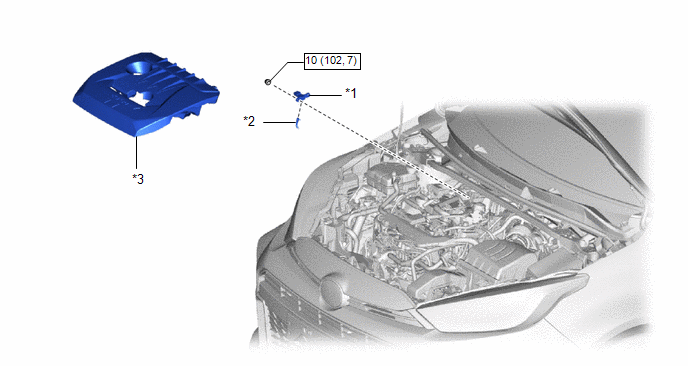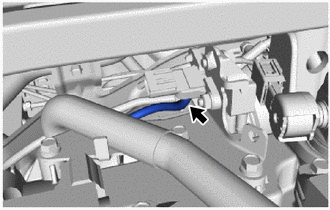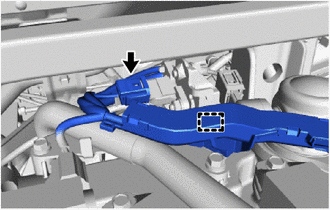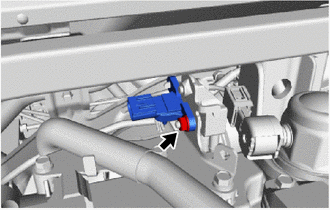Toyota Yaris: G16e-gts (engine Control) / Vacuum Sensor
Components
COMPONENTS
ILLUSTRATION

| *1 | E.F.I. VACUUM SENSOR ASSEMBLY | *2 | VACUUM HOSE |
| *3 | NO. 1 ENGINE COVER SUB-ASSEMBLY | - | - |
 | N*m (kgf*cm, ft.*lbf): Specified torque | - | - |
On-vehicle Inspection
ON-VEHICLE INSPECTION
PROCEDURE
1. INSPECT E.F.I. VACUUM SENSOR ASSEMBLY
(a) Connect the GTS to the DLC3.
(b) Start the engine.
(c) Turn the GTS on.
(d) Warm up the engine.
(e) Turn the A/C switch off.
(f) Enter the following menus: Powertrain / Engine / Data List / Turbocharger/Supercharger Inlet Pressure Bank1
Powertrain > Engine > Data List| Tester Display |
|---|
| Turbocharger/Supercharger Inlet Pressure Bank1 |
(g) Read the air pressure value from the Data List.
HINT:
- Standard atmospheric pressure is approximately 101 kPa (abs) (15 psi (abs)).
- For every 100 m (328 ft) increase in altitude, atmospheric pressure drops by approximately 1 kPa (0.15 psi). This varies by weather.
(h) Using a vacuum pump, set the E.F.I. vacuum sensor assembly.
(i) Using a vacuum pump, read the value when pressure is applied and when pressure is decreased.
OK:
The pressure values when applying pressure or decreasing pressure using the vacuum pump and the Data List values are nearly the same.
NOTICE:
- Do not apply a pressure of 50 kPa (0.5 kgf/cm2, 7.3 psi) or more to the E.F.I. vacuum sensor assembly (manifold absolute pressure sensor).
- Do not apply a vacuum of 50 kPa (375 mmHg, 14.8 in.Hg) or more to the E.F.I. vacuum sensor assembly (manifold absolute pressure sensor).
HINT:
The pressure value displayed in the Data List is the pressure value indicated on the vacuum pump with the air pressure value added.
Example:| Vacuum Pump Pressure Value | Air Pressure Value | Equation | Data List Value |
|---|---|---|---|
| When vacuum is applied at 30 kPa (225 mmHg, 8.86 in.Hg) | 100 kPa (1.0 kgf/cm2, 15 psi) | -30 + 100 = 70 | 70 kPa (0.7 kgf/cm2, 10.2 psi) |
| When pressure is applied at 20 kPa (0.2 kgf/cm2, 3 psi) | 20 + 100 = 120 | 120 kPa (1.2 kgf/cm2, 17 psi) |
Removal
REMOVAL
PROCEDURE
1. REMOVE NO. 1 ENGINE COVER SUB-ASSEMBLY
Click here

2. REMOVE E.F.I. VACUUM SENSOR ASSEMBLY
| (a) Disconnect the vacuum hose from the E.F.I. vacuum sensor assembly. |
|
| (b) Disconnect the E.F.I. vacuum sensor assembly connector. |
|
(c) Disengage the wire harness clamp.
| (d) Remove the nut and E.F.I. vacuum sensor assembly from the intake pipe or hose stay. |
|
Installation
INSTALLATION
PROCEDURE
1. INSTALL E.F.I. VACUUM SENSOR ASSEMBLY
(a) Install the E.F.I. vacuum sensor assembly to the intake pipe or hose stay with the nut.
Torque:
10 N·m {102 kgf·cm, 7 ft·lbf}
(b) Connect the E.F.I. vacuum sensor assembly connector.
(c) Engage the wire harness clamp.
(d) Connect the vacuum hose to the E.F.I. vacuum sensor assembly.
2. INSTALL NO. 1 ENGINE COVER SUB-ASSEMBLY
Click here

 Throttle Body
Throttle Body
ComponentsCOMPONENTS ILLUSTRATION
*1 AIR TUBE ASSEMBLY *2 THROTTLE BODY WITH MOTOR ASSEMBLY *3 THROTTLE BODY GASKET *4 NO. 2 THROTTLE BODY GASKET
N*m (kgf*cm, ft...
Other information:
Toyota Yaris XP210 (2020-2026) Reapir and Service Manual: Left Front Wheel Speed Sensor Circuit Short to Ground or Open (C050014)
DESCRIPTION Refer to DTC C05001F. Click here DTC No. Detection Item DTC Detection Condition Trouble Area DTC Output from C050014 Left Front Wheel Speed Sensor Circuit Short to Ground or Open An open in the speed sensor signal circuit continues for 0...
Toyota Yaris XP210 (2020-2026) Reapir and Service Manual: Charging Failure
PROCEDURE 1. CHECK GENERATOR PULLEY WITH CLUTCH (ON-VEHICLE INSPECTION) (a) Start the engine and visually check that the generator rotor assembly (fan) in the generator assembly is operating. OK: The generator rotor assembly (fan) is operating...
Categories
- Manuals Home
- Toyota Yaris Owners Manual
- Toyota Yaris Service Manual
- Power Integration No.1 System Missing Message (B235287,B235587,B235787-B235987)
- Engine Start Function When Key Battery is Dead
- Removal
- New on site
- Most important about car
Break-In Period
No special break-in is necessary, but a few precautions in the first 600 miles (1,000 km) may add to the performance, economy, and life of the vehicle.
Do not race the engine. Do not maintain one constant speed, either slow or fast, for a long period of time. Do not drive constantly at full-throttle or high engine rpm for extended periods of time. Avoid unnecessary hard stops. Avoid full-throttle starts.



